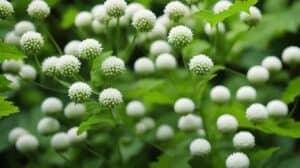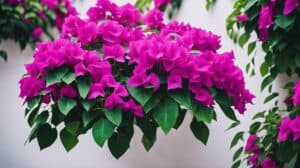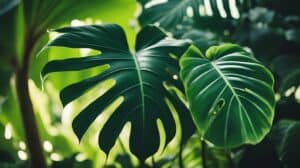The Jade Vine, also known by its scientific name Strongylodon Macrobotrys, is a rare and exotic plant that is native to the Philippines.
This stunning plant is known for its vibrant blue-green flowers that hang in long chains, making it a popular attraction for tourists and botanists alike.
Despite its popularity, the Jade Vine is still considered a threatened species due to habitat loss and over-collection.

The Strongylodon Macrobotrys is a member of the legume family, and its flowers are pollinated by bats and other nocturnal animals.
The plant requires a specific set of conditions to thrive, including a warm and humid environment with plenty of sunlight and well-drained soil.
In the wild, the Jade Vine can grow up to 18 meters long, but in cultivation, it is usually kept to a more manageable size.
Despite its delicate appearance, the Jade Vine is a hardy plant that can survive in a variety of conditions, making it a popular choice for gardens and conservatories around the world.
The Jade Vine: An Overview
Botanical Profile
The Jade Vine, also known as Strongylodon Macrobotrys, is a rare and exotic flowering plant that belongs to the legume family.
It is native to the tropical rainforests of the Philippines, specifically in the islands of Luzon, Mindanao, and Samar.
The plant is known for its unique turquoise-green flowers that grow in clusters, which can reach up to 90 cm in length.
The flowers are pea-shaped and have a distinct waxy texture.
The Jade Vine is a perennial plant that can grow up to 18 meters in length.
It has a woody stem and dark green leaves that are pinnate, meaning that they have multiple leaflets.
The plant is a member of the Fabaceae family, which includes other well-known plants such as beans, peas, and lentils.
Habitat and Distribution
The Jade Vine is native to the Philippines and is found in the tropical rainforests of the country.
It is a rare plant and is considered endangered due to habitat loss and over-harvesting.
The plant requires a specific set of conditions to grow, including a warm and humid climate, well-draining soil, and partial shade.
It is often found growing near rivers or streams, as it requires a constant supply of water.
The plant is also found in other parts of the world, including Hawaii, where it was introduced in the early 1900s.
It is also grown in botanical gardens and private collections in other parts of the world, including the United States and Europe.
In conclusion, the Jade Vine is a rare and exotic plant that is known for its unique turquoise-green flowers.
It is native to the tropical rainforests of the Philippines and is considered endangered due to habitat loss and over-harvesting.
The plant requires specific conditions to grow and is often found growing near rivers or streams.
Ecological Significance

Pollination Mysteries
The unique and intriguing flowers of the Strongylodon macrobotrys, commonly known as the Jade Vine, have been the subject of much fascination and study.
One of the most interesting aspects of these flowers is their pollination mechanism.
While it was initially believed that bats were the primary pollinators of the Jade Vine, recent studies have suggested that it may actually be bees that are responsible for this task.
One theory is that the Jade Vine has evolved to attract bees by mimicking the appearance and scent of their preferred food source – nectar from leguminous plants.
This is supported by the fact that the flowers of the Jade Vine produce a high volume of nectar, which is a key attractant for bees.
However, the exact mechanism by which the bees transfer pollen from one flower to another remains a mystery.
Conservation Status
The Jade Vine is a rare and endangered species, primarily due to habitat loss and over-collection.
It is listed as vulnerable on the IUCN Red List, and is protected by law in many countries.
Efforts are being made to conserve this species through a variety of measures, including the establishment of protected areas and the propagation of plants in botanical gardens.
One of the challenges facing conservationists is the fact that the Jade Vine is difficult to cultivate and propagate in captivity.
This is due in part to the plant’s unique pollination mechanism, which makes it difficult to produce viable seeds.
However, recent advances in plant propagation techniques have shown promise in increasing the success rate of Jade Vine cultivation.
Overall, the Jade Vine is an important species both ecologically and culturally.
Its unique flowers and pollination mechanism have captured the imagination of scientists and nature enthusiasts alike, while its endangered status highlights the importance of conservation efforts to protect our planet’s biodiversity.
Cultivation and Horticultural Appeal

Growing Strongylodon Macrobotrys
Strongylodon macrobotrys, commonly known as the Jade Vine, is a tropical plant native to the Philippines.
It is a climbing vine that can grow up to 18 meters long, with clusters of stunning, turquoise flowers that hang in long, pendulous racemes.
To grow Strongylodon macrobotrys, it is important to provide it with a warm, humid environment.
It thrives in temperatures between 20-30°C and requires plenty of water and well-draining soil.
The plant can be grown from seed or cuttings, and it is recommended to provide support for the vine to climb on.
Ornamental Uses
The Jade Vine is a highly sought-after plant for its stunning, unique flowers and its ability to add a tropical touch to any garden or greenhouse.
It is often used as a statement piece in large gardens, or as a focal point in conservatories or greenhouses.
The plant can also be trained to grow on trellises or pergolas, creating a beautiful and exotic canopy of turquoise flowers.
It is a popular choice for gardeners who are looking to add a touch of the tropics to their outdoor space.
In addition to its ornamental uses, the Jade Vine is also used in traditional medicine in the Philippines.
The leaves and stems of the plant are used to treat a variety of ailments, including headaches, fever, and inflammation.
Overall, the Strongylodon macrobotrys is a stunning and unique plant that is sure to add a touch of exotic beauty to any garden or greenhouse.
With the right care and attention, this plant can thrive and become a true showstopper.
Frequently Asked Questions

How do you care for a Strongylodon macrobotrys plant?
Jade vines are tropical plants that thrive in warm and humid conditions.
They require well-draining soil and regular watering, but be careful not to overwater them.
They also need support for their long, hanging stems to grow and climb. Pruning is necessary to keep the plant in shape and promote healthy growth.
What are the key benefits of having a jade vine in your garden?
Apart from its stunning beauty, the jade vine is an important pollinator for bees and other insects.
It also helps to maintain a healthy ecosystem by providing food and shelter for various animals.
Additionally, it is a great conversation starter and adds a unique touch to any garden or landscape.
During which season does the jade vine typically bloom?
The jade vine blooms from late spring to early summer, usually between May and June.
It produces clusters of bright turquoise flowers that are truly a sight to behold.
Can the jade vine be considered a rare species?
Yes, the jade vine is considered a rare species and is listed as endangered in its native habitat of the Philippines.
Its decline is mainly due to habitat loss and overcollection for ornamental purposes.
As such, it is important to promote conservation efforts and sustainable cultivation practices.
Are there any toxic properties in the jade vine to be aware of?
While the jade vine is generally safe, it is important to note that all parts of the plant are poisonous if ingested.
Therefore, it is best to keep it out of reach of children and pets.
What are some interesting facts about the jade vine?
- The jade vine is also known as the “emerald creeper” or “turquoise jade vine” due to the color of its flowers.
- It is a member of the pea family and is related to other legumes like beans and lentils.
- The jade vine is pollinated by bats in its native habitat.
- Its scientific name, Strongylodon macrobotrys, means “large-clustered round teeth”.
- The jade vine is a popular ornamental plant in tropical regions around the world, including Hawaii and Florida.














